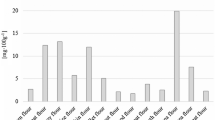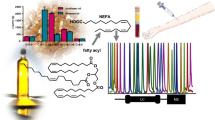Summary
Methyl isothiazolone formulations (Kathon CG) promoted as preservatives in the cosmetic field were investigated for their organic components by capillary gas chromatography/mass spectrometry. 2-methyl-3(2H)-isothiazolone and 5-chloro-2-methyl-3(2H)-isothiazolone were identified as effective major components and 4,5-dichloro-2-methyl-3(2H)-isothiazolone, 3-chloro-N-methyl-propionamide and dichloro-N-methyl-acetamide as minor components.
Various methods like thin-layer chromatography with chemical and UV-detection, high-performance thin-layer chromatography using direct optical measurement, capillary gas chromatography with nitrogen selective thermionic detector, high-performance liquid chromatography with UV- resp. diode-array-UV-detector and UV-spectrometry were applied for detection and identification of the compounds.
For quantitative determination it was necessary to obtain the corresponding purified isothiazolones as reference compounds. Commercial formulations were fractionated by reversed phase flash chromatography. Then the exact composition of the fractions obtained was determined by an absolute method, based on chemical reaction on a semi-micro scale. These solutions were used as reference for calibration. For quantitative determination of 2-methyl-3(2H)-isothiazolones reversed phase HPLC has proved to posess good reliability using the internal standard method (2-acetyl-5-chlorothiophen). Response factors and the relative calibration curves for this method were ascertained.
A special technique based on extractive separation and purification by flash chromatography was developed for the isolation of 2-methyl-3(2H)-isothiazolone and 5-chloro-2-methyl-3(2H)-isothiazolone from cosmetic products. The average recovery rates and detection limits are given. The method was tested an several different commercial cosmetics. The samples contained between 5.5 and 39.4 mg/kg of methylisothiazolones.
Zusammenfassung
Für den kosmetischen Bereich als Konservierungsmittel angebotene Methylisothiazolon-Formulierungen (Kathon CG) wurden mittels Kopplung von Capillar-Gaschromatographie und Massenspektrometrie auf ihre organischen Bestandteile untersucht. 2-Methyl-3(2H)-isothiazolon und 5-Chlor-2-methyl-3(2H)-isothiazolon wurden als Majorwirkkomponenten sowie 4,5-Dichlor-2-methyl-3(2H)-isothiazolon, 3-Chlor-N-methylpropionamid und Dichlor-N-methylacetamid als Minorbestandteile identifiziert.
Zum Nachweis und zur Identifizierung der Verbindungen wurden verschiedene Methoden wie Dünn schichtchromatographie mit chemischer und UV-Detektion, Hochleistungs-Dünnschichtchromatographie mit optischer Direktausmessung, Capillar-Gaschromatographie u. a. mit stickstoffselektivem thermionischeu Detektor, Hochleistungs-Flüssigchromatographie mit UV- bzw. Photodioden-Array-UV-Detektor sowie die UV-Spektrometrie eingesetzt.
Für die Durchführung quantitativer Bestimmungen war es zunächst notwendig, die entsprechenden Referenzisothiazolone in Reinform zu gewinnen. Die Fraktionierung aus handelsüblichen Formulierungen wurde mit Hilfe der Umkehrphasen-Flashchromatographie vorgenommen. Die exakten Gehalte der erhaltenen Fraktionen an Methylisothiazolonen wurden anschließend mit einer auf chemischer Umsetzung basierenden, im Halbmikromaßstab ausgeführten maßanalytischen Absolutmethode bestimmt und die Lösungen als Referenzen für Eichmessungen verwendet. Zur quantitativen Bestimmung der 2-Methyl-3(2H)-isothiazolone hat sich die HPLC an Umkehrphasen unter Anwendung der Methode des Internen Standards (2-Acetyl-5-chlorthiophen) sehr gut bewährt. Für diese Methode wurden die relativen Eichfunktionen sowie die Kalibrierungsfaktoren ermittelt.
Zur Isolierung von 2-Methyl-3(2H)-isothiazolon und 5-Chlor-2-methyl-3(2H)-isothiazolon aus kosmetischen Mitteln wurde ein spezielles Abtrennverfahren basierend auf extraktiver Abtrennung und flashchromatographischer Reinigung entwickelt. Es wurde bedarfsgerecht an die anschließende Bestimmung mittels Umkehrphasen-HPLC angepaßt. Die durchschnittlichen Wiederfindungsraten und Nachweisgrenzen werden angegeben.
Die vorgestellte Methode wurde an einer Anzahl von verschiedenartigen, mit Methylisothiazolonen konservierten handelsüblichen Cosmetica geprüft. Diese Untersuchung hatte zum Ergebnis, daß die Gesamtmethylisothiazolon-Gehalte der Proben in einen Bereich von 5,5 bis 39,4 mg/kg variieren, in jedem Fall jedoch (z.T. weit) unterhalb der zulässigen Höchst konzentration liegen.
Similar content being viewed by others
Literatur
Holler W (1981) memo script 4/81. Concept Heidelberg 2:63
Schmahl HJ (1979) Datenblattsammlung antimikrobiell wirksamer Substanzen in Cosmetica. MvP-Berichte 2/1979. D Reimer, Berlin
Fiedler HP (1981) Lexikon der Hilfsstoffe für Pharmazie, Kosmetik und angrenzende Gebiete. Editio Cantor, Aulendorf
Bathe P (1978) Manufact Chem Aerosol News 49:44
Rohm & Haas (1983) Merkblatt Kathon CG/ICP. CS-486
Rohm & Haas (1983) Merkblatt Kathon CG Preservative. Material Safety Data Sheet List 7
Schälke & Mayr (1984) Produktionsinformation Euxyl K 100 bzw. Merkblatt Euxyl K 100
Matissek R, Wittkowski R (1984) Fresenius Z Anal Chem 318:414
Lewis SN, Miller GA, Szamborski EC, Hausman M (1971) J Heterocyclic Chem 8:571
Miller GA, Weiler ED, Hausman M (1971) J Heterocyclic Chem 8:581
Beilfuß W, Bestmann G (1977) Arch Pharm 310:216
Pham Due TL, Papaconstantin E, Etienne JJ (1983) Int J Cosmetic Sci 5:29
Matissek R, Dross A, Häussler M (1984) Fresenius Z Anal Chem 319:520
Matissek R, Harper B, Lehnguth R (1985) Fresenius Z Anal Chem 322:465
Matissek R, Häussler M, Harper B (1986) Fresenius Z Anal Chem (im Druck)
Lewis SN, Miller GA, Hausman M, Szamborski EC (1971) J Heterocyclic Chem 8:587
Lewis SN, Miller GA, Hausman M, Szamborski EC (1971) J Heterocyclic Chem 8:591
Miller GA, Hausman M (1971) J Heterocyclic Chem 8:657
Gesetz über den Verkehr mit Lebensmitteln, Tabakerzeugnissen, kosmetischen Mitteln und sonstigen Bedarfsgegenständen (Lebensmittel-und Bedarfsgegenständegesetz) vom 15.8.1974 (BGBl I S 1946)
Verordnung über kosmetische Mittel (Kosmetik-Verordnung) vom 16.12.1977 (BGBl I S 2589) i.d.F. vom 19.6.1985 (BGBl I S1082)
Richtlinie der Kommission vom 18.7.1984 zur Anpassung der Anhänge II, III, IV, V und VI der Richtlinie 76/768/EWG des Rates zur Angleichung der Rechtsvorschriften der Mitgliedsstaaten über kosmetische Mittel (84/425/EWG). ABI EG Nr L 228/31 vom 25.8.1984
Matissek R (1985) Unveröffentlichte Arbeiten
Van den Dool H, Kratz P (1963) J Chromatogr 11:463
MICHEL-Farbenführer. Schwaneberger Verlag, München
Bürger K (1963) Fresenius Z Anal Chem 310:216
Still WC, Kahn M, Mitra A (1978) J Org Chem 43:2923
Baker Research Products (1982) Flash Chromatography —Columns and Sorbents. Instructions 2/82
Dobler W (1983) GIT Fachz Lab 27:1078
Crane LJ, Zief M, Horvath J (1981) Am Lab 13:128
Matissek R, Häussler M (1985) Dtsch Lebensur Rdsch 81:50
Gutknecht J (1985) Private Mitteilungen
Schönhals HJ (1984, 1985) Private Mitteilungen
Reeve P (1985) Private Mitteilungen
Author information
Authors and Affiliations
Rights and permissions
About this article
Cite this article
Matissek, R. Konservierungsstoffe auf Basis von Methylisothiazolonen in kosmetischen Mitteln — Grundlagen und Analytik. Z Lebensm Unters Forch 183, 273–289 (1986). https://doi.org/10.1007/BF01087743
Received:
Issue Date:
DOI: https://doi.org/10.1007/BF01087743




